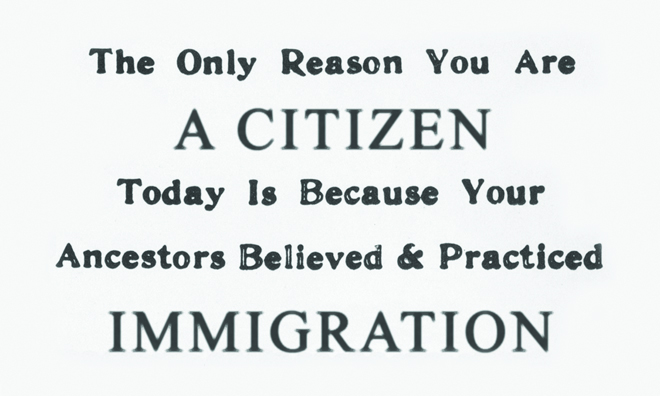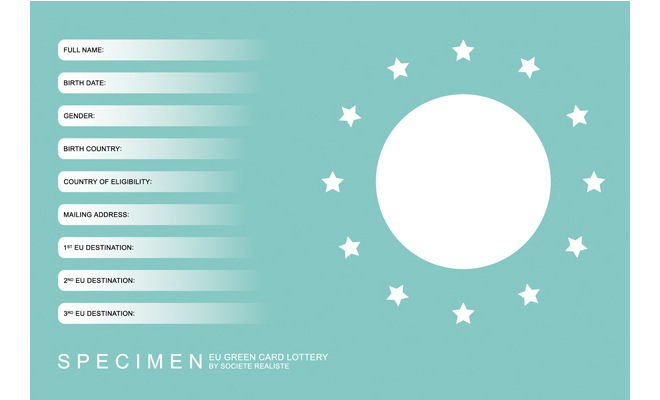Review: "Where Do We Migrate To?"

Fereshteh Toosi, The Only Reason, 2006. Offset lithograph business cards. Courtesy the artist.*
In the second-floor gallery of the Contemporary Arts Center, a stack of business cards is piled high on a small stand protruding from the wall. Although the cards are tiny, the statement printed on each is powerful: The Only Reason You Are A CITIZEN Today Is Because Your Ancestors Believed & Practiced IMMIGRATION. The artist Fereshteh Toosi, who identifies as first-generation Iranian-American, détourned the slogan from a 1970s Ku Klux Klan membership card that read: The Only Reason You Are WHITE Today Is Because Your Ancestors Believed & Practiced SEGREGATION. This particular piece, while humble, confronts many facets under investigation in “Where Do We Migrate To?” from mobility and human rights to the examination of the contemporary vis-à-vis the past.
Rather than addressing migration from the oft-sensationalizing standpoint taken by the media, the exhibition highlights works that quietly position the migrant as subject in an effort to help us understand experiences of transience and translocation in our global society. With an exceptional roster of international artists working in different modes, the exhibition raises questions such as: Why and how do we move? What do we gain or leave behind when we move? Once in a new place are we faced with hostility or hospitality?
Considering these questions, it’s fitting that upon entering the exhibition visitors are immediately engulfed in a soundscape that is both chaotic and rhythmic. Created by a mixture of various works on display, the combined effect is that of a busy metropolitan center. The sensation is readily reflected in the silent video A Needle Woman - Paris, 2009, in which the artist Kimsooja stands still in the middle of a sidewalk with her back to the camera as droves of people pass by. A Korean native, she has replicated this peacefully defiant action in multiple cities, including Patan, Nepal, and N’Djamena, Chad, underscoring the uncertainties of entering and striving to belong to a new community while maintaining one’s own cultural identity.

Société Réaliste, EU Green Card Lottery, on-going since 2005. Installation, materials variable. Courtesy the artists.
The United States, as Fereshteh Toosi articulates on her small cards, is indeed a nation of immigrants, and, like Toosi, a few exhibiting artists here take on immigration debates within the U.S. as their focus. Working closely with advocacy groups, Pedro Lasch’s ongoing LATINO/A AMERICA project gives individuals immigrating to the U.S. from Mexico two maps to carry during their journey—one to keep and one to mail back from their final destination. The paper maps hanging on the wall of the CAC are but three of a total group of seven returned maps originally given to thirty individuals for their voyage in the North Carolina Arrival Edition. The maps, folded, torn, and discolored, are presented alongside written excerpts of the carrier’s experiences during his or her migration. Lasch’s placement of the word “LATINO/A” on the map’s image of North America and “AMERICA” on South America simultaneously demonstrates shared, albeit contested, understandings of language and territory.
Responding to the forces beyond our control that govern our ability to move, Société Réaliste created the interactive installation EU Green Card Lottery, 2005-ongoing. In an improvised aqua-green office positioned in the back of the main gallery, visitors can complete an online application for a green card for the European Union—a possibility that can’t be realized. A sinister commentary on U.S. and European immigration policies and the variegated effects international policies have on people around the world, this piece toys with the hopes of individuals wanting to join a different society and create a new life.
In “Where Do We Migrate To?” it seems especially important to consider that each artist’s practice and each viewer’s interpretations are dictated by his or her specific experiences and understandings of home and belonging. There is no doubt that exhibition curator Niels Van Tomme’s relocation from Europe to the U.S. influenced the conception of this exhibition alongside other inspirations such as Roberto Bolaño’s posthumously published novel 2666. Whether prompted by fact or fiction, “Where Do We Migrate To?” impels us to examine the many dimensions of migration we experience today, while also urging us to consider our future together as histories, economies, and cultures continuously coincide.
Editor's Note
“Where Do We Migrate To?” on view through January 20 at the Contemporary Arts Center (900 Camp Street) in New Orleans.
The artist Fereshteh Toosi encourages visitors to her website to download their own copies of The Only Reason business cards for distribution. To download in pdf format, click here.



